C#中的枚举器和迭代器
Posted 康凯哇咔咔
tags:
篇首语:本文由小常识网(cha138.com)小编为大家整理,主要介绍了C#中的枚举器和迭代器相关的知识,希望对你有一定的参考价值。
目录
3. 使用 IEnumerable 和 IEnumerator 案例
一、可枚举类型和枚举器
数组为什么可以被foreach语句处理?原因是数组按需提供了一个枚举器对象。
- foreach结构设计用来和可枚举类型一起使用。
- 可枚举类型可以通过GetEnumerator方法获取对象的枚举器。
- 从枚举器中请求每一项并且把它作为迭代变量,该变量是只读的。

1. 枚举器
枚举器需要实现IEnumerator接口,其中包含三个函数成员:Current、MoveNext、Reset。
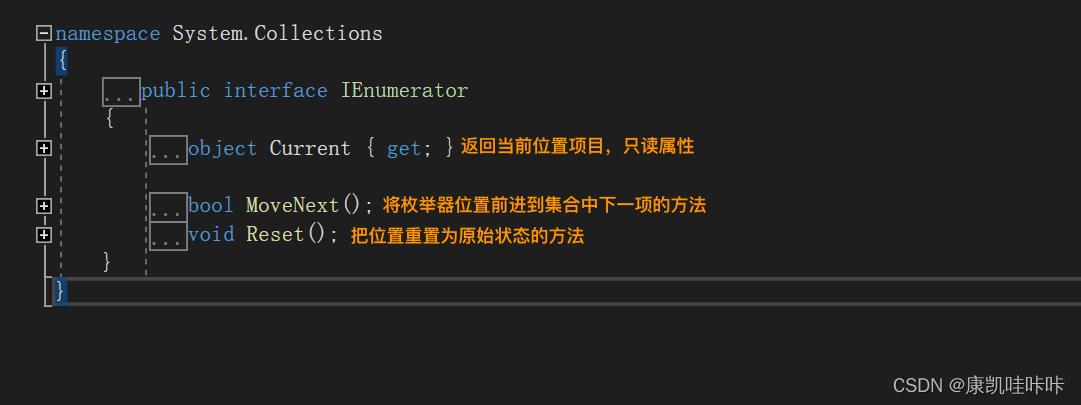
因为数组是可枚举类型,所以我们可以通过GetEnumerator方法获取其枚举器对象,来模拟foreach遍历,通过模拟我们可以初步认识枚举器接口中的这三个方法。
internal class Program
static void Main(string[] args)
int[] ints = 5, 6, 7 ;
IEnumerator enumerator = ints.GetEnumerator();//获取数组的枚举器对象
while (enumerator.MoveNext()) //MoveNext方法移动指向数组中下标的指针位置,并判断是否在数组长度范围内,返回一个bool值
int current = (int)enumerator.Current;//获取当前指针指向的元素
Console.WriteLine(current);
bool beforeReset = enumerator.MoveNext();
Console.WriteLine("位置重置为原始位置之前,enumerator.MoveNext()方法返回:0", beforeReset);
enumerator.Reset();//将位置重置为原始状态
//当位置没有重置时,enumerator.MoveNext()返回fasle,所以不会进入这个while循环,无法遍历
while (enumerator.MoveNext())
int current = (int)enumerator.Current;
Console.WriteLine(current);
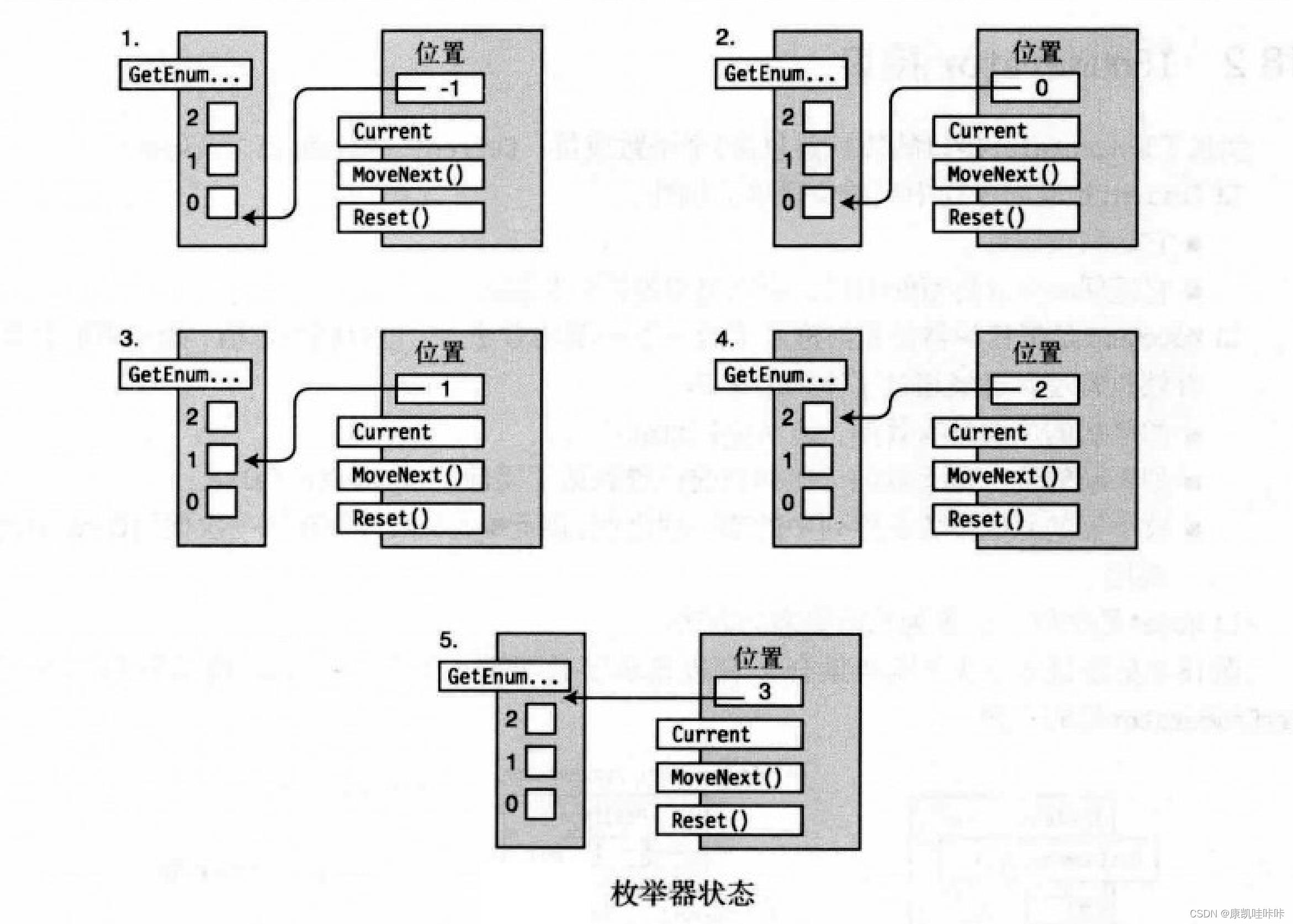
2. 可枚举类
前面说过数组是可枚举类型,其原因在于数组实现了IEnumerable接口。可枚举类就是指实现了IEnumerable接口的类。

综上,可枚举类型是实现了IEnumerable接口的类,实现了IEnumerable接口中的GetEnumerator方法返回一个枚举器,枚举器是实现了 IEnumerator接口的类,通过实现IEnumerator接口三个方法来访问元素。理解图如下:
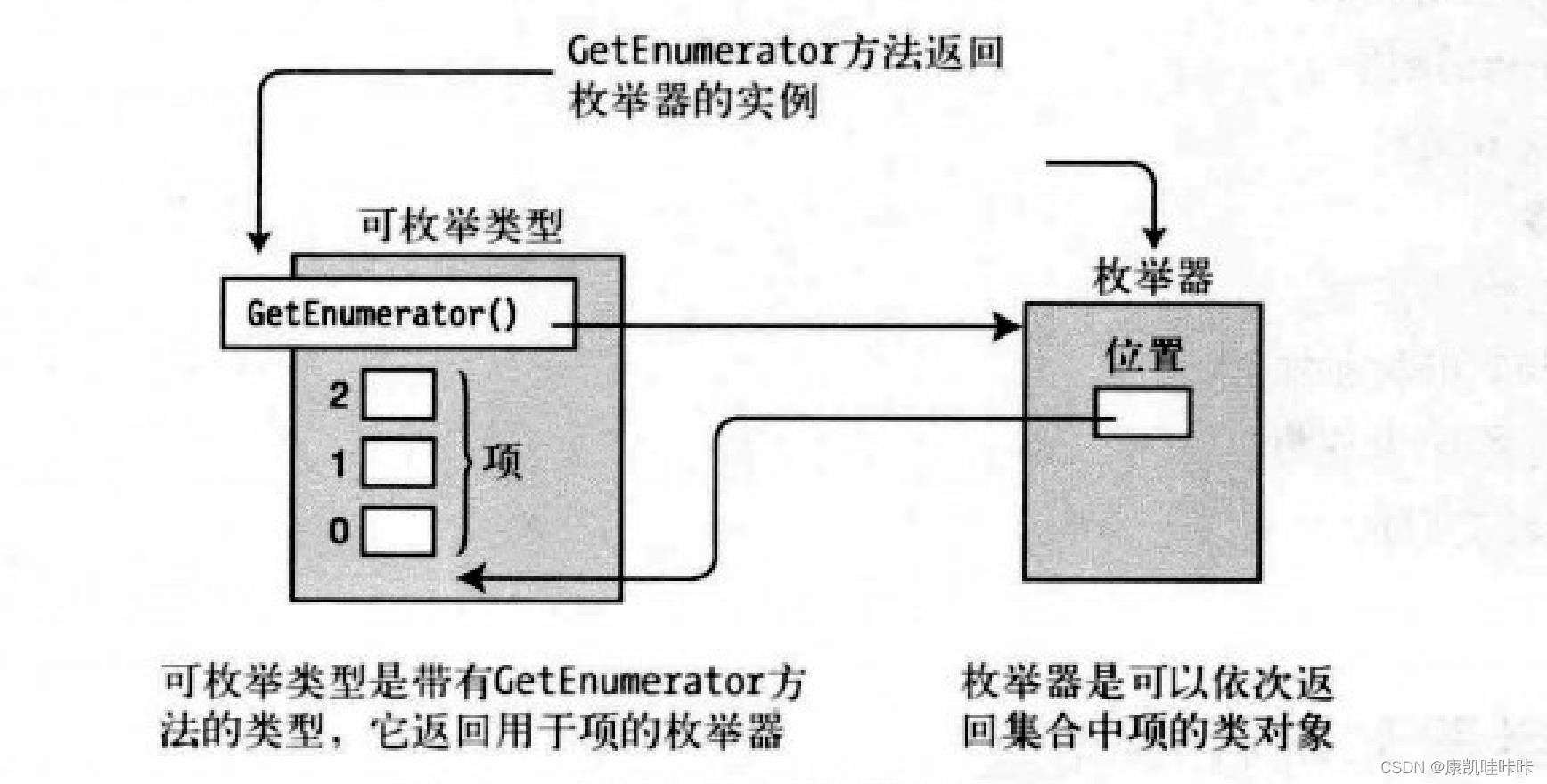
3. 使用 IEnumerable 和 IEnumerator 案例
//枚举器
class ColorEnumerator : IEnumerator
string[] _colors;
int _position = -1;
public ColorEnumerator(string[] colors)
_colors = new string[colors.Length];
Array.Copy(colors,_colors,colors.Length);
public object Current
get
if (_position == -1)
throw new InvalidOperationException();
if (_position >= _colors.Length)
throw new InvalidOperationException();
return _colors[_position];
public bool MoveNext()
if (_position < _colors.Length - 1)
_position++;
return true;
else
return false;
public void Reset()
_position = -1;
//可枚举类型
class Spectrum : IEnumerable
string[] colors = "赤", "橙", "黄", "绿", "青", "蓝", "紫" ;
public IEnumerator GetEnumerator()
return new ColorEnumerator(colors);
//测试
internal class Program
static void Main(string[] args)
Spectrum colors = new Spectrum();
foreach (string color in colors)
Console.WriteLine(color);
4. 泛型枚举接口
- 泛型枚举接口的使用和非泛型枚举接口的使用是差不多的
- 非泛型枚举接口的实现不是类型安全的,它们返回object类型的引用,必须强转位实际类型
- 泛型枚举接口的实现是类型安全的,它们返回的是实际类型的对象,而非object基类的引用
- 应该尽量使用泛型枚举接口
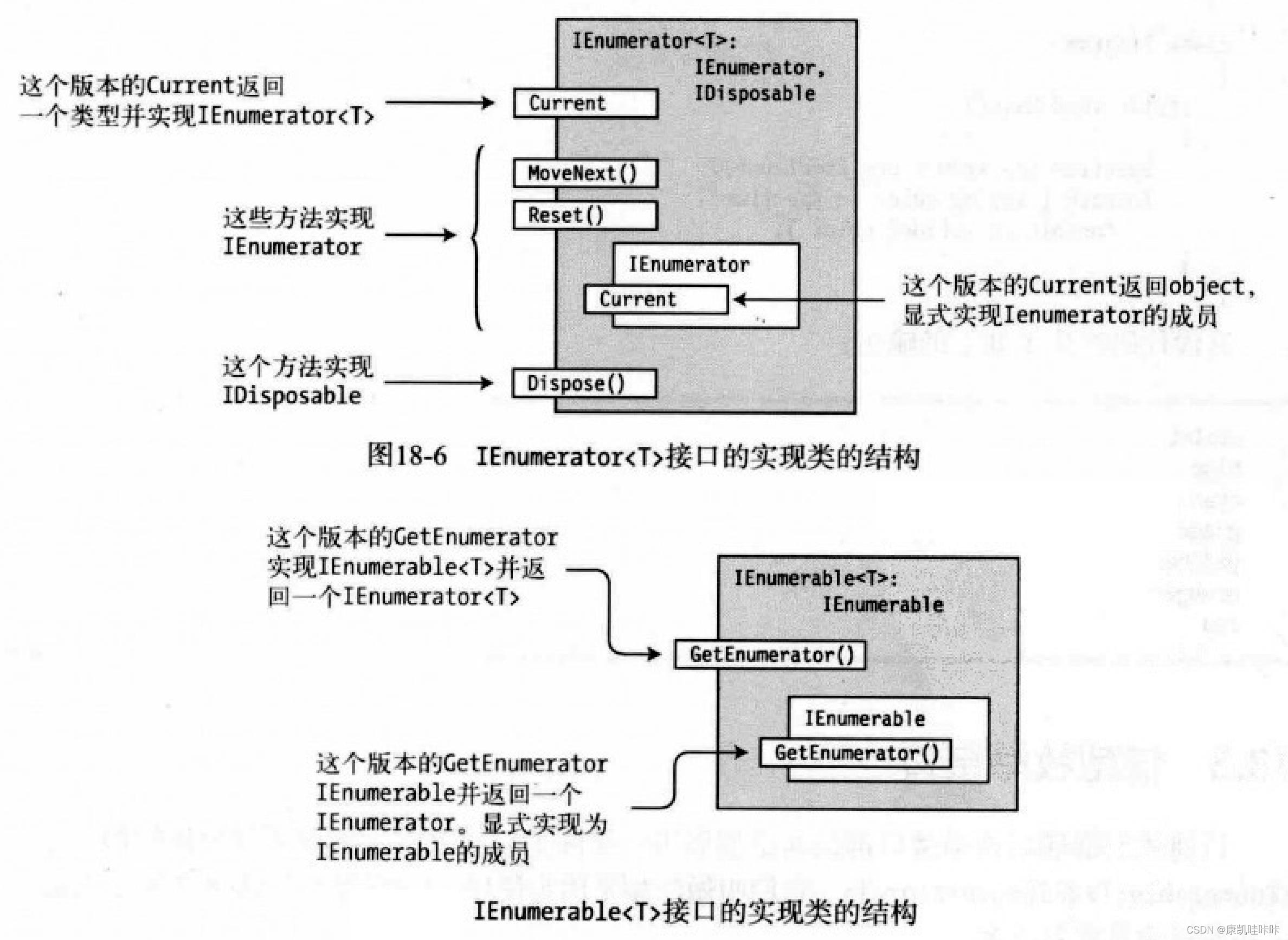
二、迭代器
- 迭代器可以代替我们手动编码的可枚举类和枚举器。
- 迭代器块是有一个或多个yield语句的代码块。
- 迭代器块描述了希望编译器为我们创建的枚举器类的行为。
- 迭代器块可以是方法主体、访问器主体或运算符主体。
- 迭代器块中有两个特殊语句:
i. yield return语句指定了序列中返回的下一项
ii.yield break语句指定在序列中没有其他项

1. 使用迭代器创建枚举器
代码示例:
class MyClass
public IEnumerator<string> GetEnumerator() //返回枚举器
return BlackAndWhite();
public IEnumerator<string> BlackAndWhite() //迭代器块
yield return "赤";
yield return "橙";
yield return "黄";
yield return "绿";
yield return "青";
yield return "蓝";
yield return "紫";
//测试
internal class MyTest
static void Main(string[] args)
MyClass myClass = new MyClass();
foreach (string element in myClass)
Console.WriteLine(element);
代码图解:
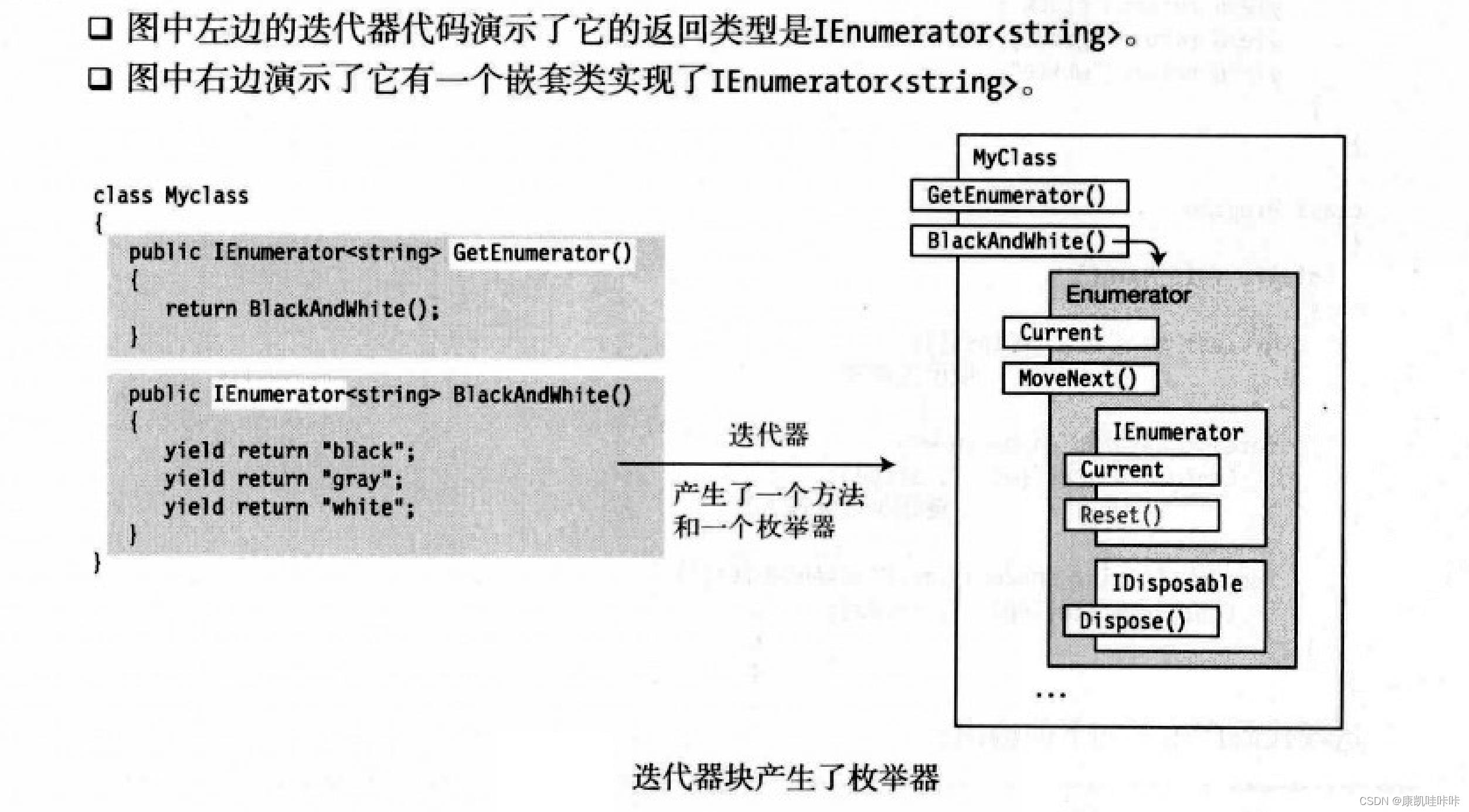
2. 使用迭代器创建可枚举类
代码示例:
class MyClass
public IEnumerator<string> GetEnumerator() //返回枚举器
return BlackAndWhite().GetEnumerator();//返回从可枚举类获取的枚举器
public IEnumerable<string> BlackAndWhite() //返回可枚举类
yield return "赤";
yield return "橙";
yield return "黄";
yield return "绿";
yield return "青";
yield return "蓝";
yield return "紫";
//测试
internal class MyTest
static void Main(string[] args)
MyClass myClass = new MyClass();
foreach (string element in myClass)//让类本身可枚举
Console.WriteLine(element);
Console.WriteLine("--------");
foreach (string element in myClass.BlackAndWhite())//调用返回可枚举类的方法
Console.WriteLine(element);
代码图解:
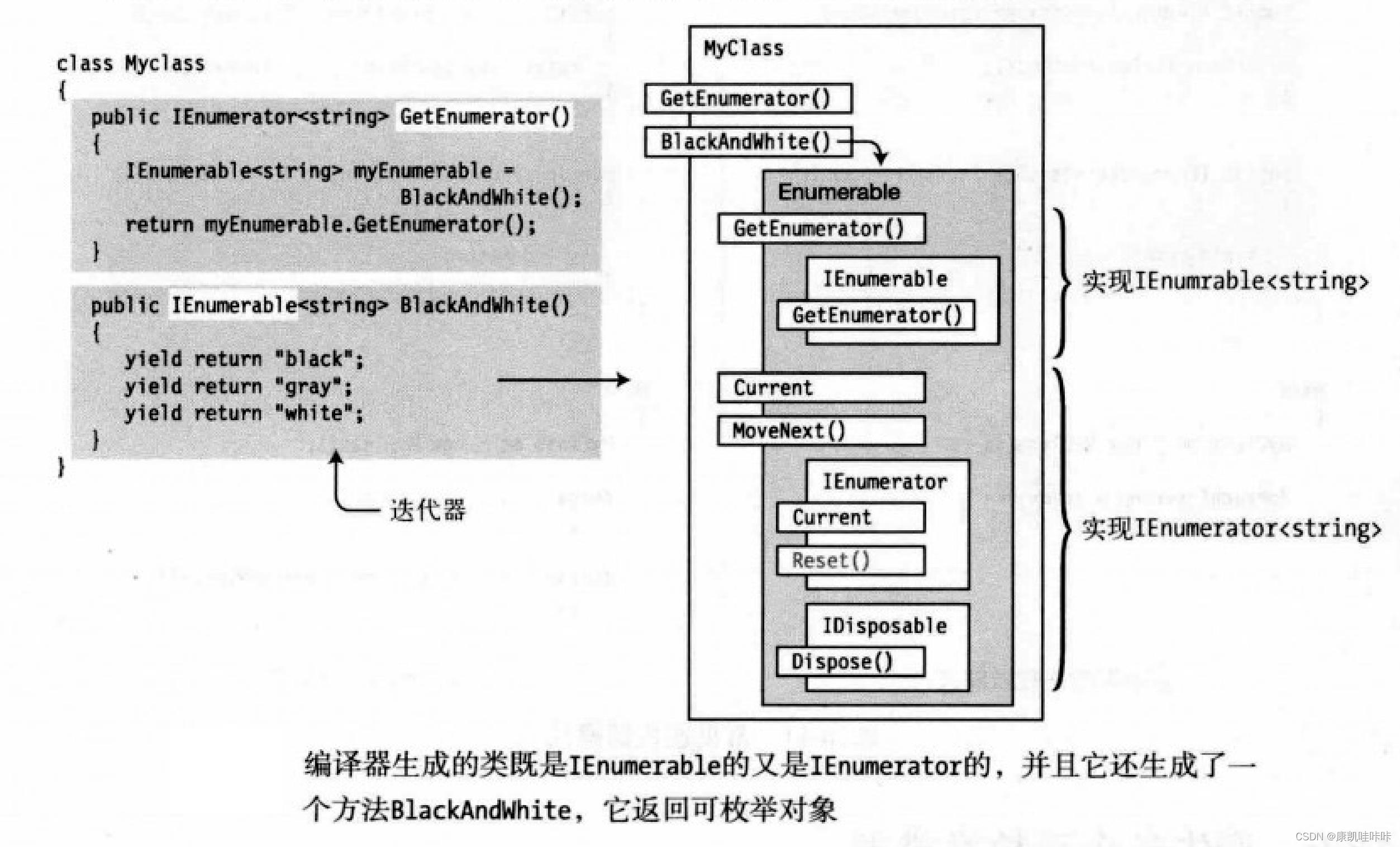
3. 常见的迭代器模式
通过前面的代码案例,创建迭代器可以用来产生可枚举类型和枚举器。总结如下:
- 如果我们创建返回枚举器的迭代器时,必须实现GetEnumerator方法来让类可枚举。
- 如果我们创建返回可枚举类型的迭代器时,我们有两种选择:
选择1:实现GetEnumerator让类本身可枚举
选择2:不实现GetEnumerator让类本身不可枚举,但仍可使用由迭代器产生的可枚举类
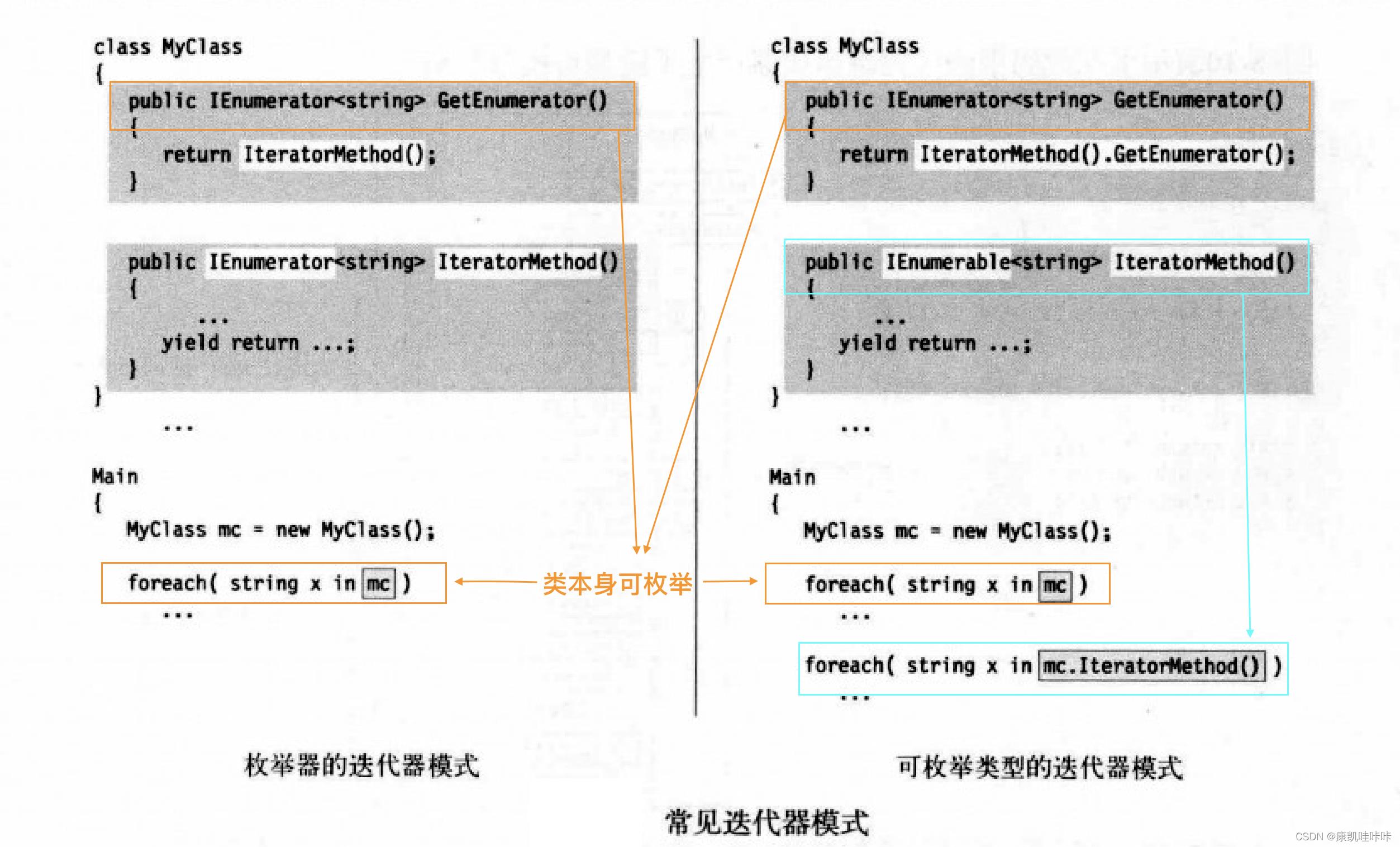
4. 产生多个枚举类型
可以在同一个类中创建多个迭代器来产生多个枚举类型。
//注意:该类中没有实现GetEnumerator方法,所以该类本身不可以被枚举,但可以通过迭代器返回的枚举类型进行遍历
class MyClass
string[] colors = "赤", "橙", "黄", "绿", "青", "蓝", "紫" ;
public IEnumerable<string> PrintOut() //迭代器返回可枚举类型
for (int i = 0; i < colors.Length; i++)
yield return colors[i];
public IEnumerable<string> ReversePrintOut() //迭代器返回可枚举类型
for(int i = colors.Length-1; i >= 0; i--)
yield return colors[i];
//测试
internal class MyTest
static void Main(string[] args)
MyClass myClass = new MyClass();
foreach (string color in myClass.PrintOut())
Console.WriteLine(color);
Console.WriteLine("--------");
foreach (string color in myClass.ReversePrintOut())
Console.WriteLine(color);
5. 将迭代器作为属性
可以将迭代器作为属性。代码示例如下:
class Colors
bool chooseEnumerator;
string[] colors = "赤", "橙", "黄", "绿", "青", "蓝", "紫" ;
public Colors(bool b)
chooseEnumerator = b;
//根据创建类对象时传入的布尔值控制返回不同的枚举器
public IEnumerator<string> GetEnumerator()
return chooseEnumerator ? PrintOut : ReversePrintOut;
public IEnumerator<string> PrintOut //迭代器放置在属性get访问器中
get
for (int i = 0; i < colors.Length; i++)
yield return colors[i];
public IEnumerator<string> ReversePrintOut //迭代器放置在属性get访问器中
get
for (int i = colors.Length - 1; i >= 0; i--)
yield return colors[i];
//测试
internal class MyTest
static void Main(string[] args)
Colors colors = new Colors(true);
foreach (string color in colors)
Console.WriteLine(color);
Console.WriteLine("--------");
Colors reColors = new Colors(false);
foreach (string color in reColors)
Console.WriteLine(color);
6. 迭代器的实质
- 迭代器需要using指令引入System.Collections.Generic的命名空间。
- 在编译器生成的枚举器中,Reset方法没有实现,调用会抛异常。
- 由编译器生成的枚举器是包含四个状态的状态机。
- Before:首次调用MoveNext的初始状态。
- Running:调用MoveNext后进入这个状态。在这个状态中,枚举器检查并设置下一项的位置,在遇到yield return、yield break或在迭代器体结束时,退出状态。
- Suspended:状态机等待下次调用MoveNext的状态。
- After:没有更多项可以枚举。
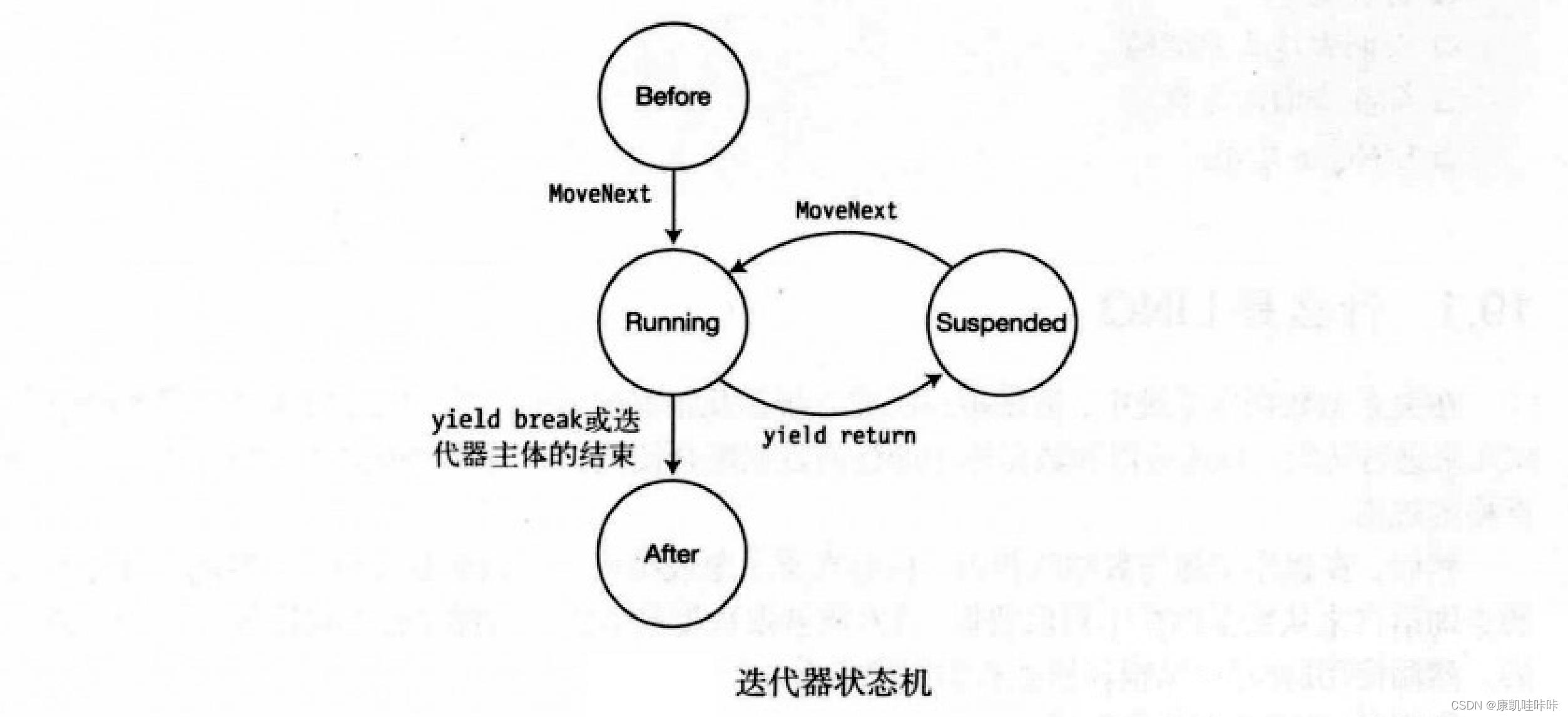
(注:本章学习总结自《C#图解教程》)
python -- 迭代器和装饰器
迭代器和装饰器在python中的使用十分常见,下面是个人对迭代器和装饰器的理解
迭代器
1、迭代器 iter 的特点:
(1).访问者不需要关心迭代器的内部结构,仅需要通过__next__()方法不断去取下一个内容
(2).不能随机访问集合(不是set,只是一些元素的聚集体)中的某个值,只能从头到尾依次访问
(3).访问到一半时不能后退(过去的就过去了,不能回头)
(4).便于循环比较大的数据集合,节省内存(每次需要了指定数据时,才把该读取到内存中,eg:迭代文件时,内存中每一时刻都只有文件的一行)
1 a = iter([‘root‘,‘admin‘,‘python‘,‘ruby‘ ]) #生成一个迭代器 2 print(a.__next__()) 3 print(a.__next__()) #只有一个__next__() 方法 4 print(‘waitting!‘) #在第二代的过程中,能停下来做其他的事 5 print(a.__next__()) 6 print(a.__next__()) 7 #print(a.__next__()) #报错 超出迭代器范围
常见迭代器使用:
读文件时:
with open(‘a*.txt‘,‘r+‘) as f:
for line in f:
...
这里的for i in f:就是用的迭代器,避免依次把文件内容全部读取到内存中,节省内存。
在介绍迭代器时,还有个概念要明白,何为生成器
生成器 generator
定义: 一个函数调用时返回一个迭代器,那么这个函数就叫做生成器,如果函数中包含了yield语法,那么这个函数就会变成一个生成器(保存函数的中断状态)
1 >>> 2 >>> def test_yeild(n): 3 while n > 0: 4 n -= 2 5 yield 10 6 print(‘注意何时打印这句话...‘) 7 8 9 >>> t = test_yeild(12) # 与普通函数不同,这里只是生成一个迭代器,不会跳到‘函数体’里面去(执行函数体),而是等待迭代器的__next__()方法 10 >>> t.__next__() 11 10 # 返回yield后面的值,并在执行完yield后 暂停程序 ,等待下一次__next__(),然后接着从暂停的地方开始运行 12 >>> t.__next__() 13 注意何时打印这句话... 14 10 15 >>> t.__next__() 16 注意何时打印这句话... 17 10 18 >>> t.__next__() 19 注意何时打印这句话... 20 10 21 >>> t.__next__() 22 注意何时打印这句话... 23 10 24 >>> t.__next__() 25 注意何时打印这句话... 26 10 27 >>> t.__next__() 28 注意何时打印这句话... 29 Traceback (most recent call last): 30 File "<pyshell#162>", line 1, in <module> 31 t.__next__() 32 StopIteration 33 >>>
yield 可以返回一个值,也可以接收一个值,给yield传值用send()
看下面例子,用yield做了个简单的异步操作:
1 import time 2 3 def consumer(name): 4 print("%s 准备吃包子啦!" %name) 5 while 1: 6 baozi = yield 7 print("包子[%s]来了,被[%s]吃了" %(baozi,name)) 8 9 def producer(name): 10 c = consumer(‘A‘) 11 c2 = consumer(‘B‘) 12 c.__next__() 13 c2.__next__() 14 print("%s开始准备做包子啦!" %name) 15 for i in range(3): 16 time.sleep(1) #执行时为了更清楚的看到过程 17 print("做了2个包子") 18 c.send(i) 19 c2.send(i) 20 22 producer(‘root‘)
A 准备吃包子啦! B 准备吃包子啦! root开始准备做包子啦! 做了2个包子 包子[0]来了,被[A]吃了 包子[0]来了,被[B]吃了 做了2个包子 包子[1]来了,被[A]吃了 包子[1]来了,被[B]吃了 做了2个包子 包子[2]来了,被[A]吃了 包子[2]来了,被[B]吃了
1 def account(money): 2 while money > 0: 3 out_money = yield 4 money -= out_money 5 #yield 300 6 print(‘又来取钱了!取了%s‘ %out_money) 7 8 atm = account(1500) 9 atm.__next__() 10 for i in range(5): 11 atm.send(300) 12 #在第一次用__next__()方法启动迭代器后,每次调用迭代器,就会自动执行__next__()方法 13
装饰器
装饰器基本功能:对已有函数进行扩展
(个人初步理解,可能错误)
装饰器执行过程:
1.在调用被装饰器装饰的函数时,先把被装饰器装饰的函数(装饰器下一行代码中函数)的函数名传递给装饰器从内到外第二层定义的函数
2.把被装饰器装饰的函数的实参传递给装饰器最内层函数
3.在装饰器内部实现被装饰器装饰的函数的调用
简单装饰器:
1 def login(func): 2 def inner(*args,**kwargs): 3 print("我是做身份验证的,验证成功才能调用函数") 4 print(args,kwargs) 5 func(*args,**kwargs) 6 #return func(*args,**kwargs) 7 return inner 9 #若传进来的是函数名,那么没有执行‘()‘的话,即是函数的内存地址 10 11 #@login #(装饰器)程序一执行,就会调用装饰器的函数 12 def home(name): 13 print("welcome [%s] vidited the home page" %name) 14 15 @login #@符号的作用: 相当于执行 tv = login(tv) 16 #def tv(name,passwd=123): 17 def tv(*args,**kwargs): 18 print("welcome [%s] vidited the tv page" %args ) 19 #若这里有返回值,则仅需要在inner里面返回函数结果 20 #@login 21 def movices(name): 22 print("welcome [%s] vidited the movices page" %name) 23 24 tv(‘root‘) 25 tv(‘xtsec‘,passwd=123)
复杂装饰器:
1 ‘‘‘ 2 调用装饰器时(eg:@login(f1,f2)),传递多个参数的装饰器(三层装饰器) 3 ‘‘‘ 4 def before(): 5 print("执行要装饰的函数之前执行") 6 7 def affter(): 8 print("执行要装饰的函数之后执行") #没有return的函数默认返回None 9 10 def test_ge(before1,affter1): 11 def login(func): 12 def inner(*args,**kwargs): 13 result_before = before1() 14 if(result_before != None): 15 return ‘执行before条件未成功!‘ #这里运行就表示before函数没有正确运行结束,所以表示验证没通过 16 ret = func(*args,**kwargs) 17 if(ret != None): 18 return ‘执行被修饰函数不成功!‘ #若前面验证通过,且装饰器正确执行,到这里整个装饰器运行结束 19 result_afftr = affter1() 20 if(result_afftr != None): 21 return ‘执行时不满足要求!‘ #若前面装饰器修身的函数没正确运行,就会到这里,常用来返回错误信息 22 return ret 23 return inner 24 return login 25 26 def home(name): 27 print("welcome [%s] vidited the home page" %name) 28 29 ‘‘‘ 30 接下来这一行有三个操作: 31 1.调用函数 test_ge(before, affter) 32 [email protected] login为调用test_ge(before, affter)的返回值 33 3.新tv = inner login()的返回值 34 ‘‘‘ 35 @test_ge(before, affter) 36 def tv(*args,**kwargs): 37 print("welcome [%s] vidited the tv page" %args ) 38 return 1 39 40 def movices(name): 41 print("welcome [%s] vidited the movices page" %name) 42 43 44 tv(‘root‘,passwd=‘admin‘) 45 #在这里执行tv()时,事实上时执行新的tv(),即是inner() 46 a = before() 47 print(type(a),a) 48 if a == None: 49 print(‘110‘)
在日常使用中,一般就用普通的装饰器,复杂度这个最好明白运行原理即过程
以上是关于C#中的枚举器和迭代器的主要内容,如果未能解决你的问题,请参考以下文章